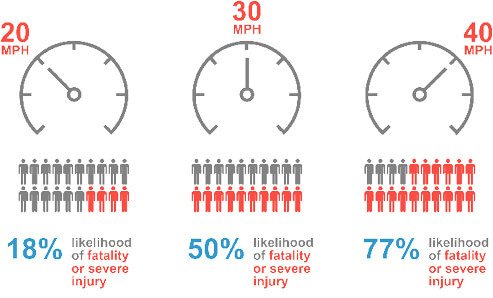Sharing the Road
Sharing the road – part one
Trucks: When driving on the highway, you are at a serious disadvantage if involved in a crash with a larger vehicle. In crashes involving large trucks, the occupants of a car – usually the driver – sustain 78 percent of fatalities.
In order to keep you and your teen safe on the road, you should be extra cautious when driving around large trucks and buses. Sharing the road with larger vehicles can be dangerous if you are not aware of their limitations. Here are a few tips to help you drive safer to prevent a crash and minimize injuries and fatalities if one does occur:
Cutting in front can cut your life short: If you cut in front of another vehicle, you may create an emergency-braking situation for the vehicles around you, especially in heavy traffic. Trucks and buses take much longer to stop in comparison to cars. When passing, look for the front of the truck in your rearview mirror before pulling in front, and avoid braking situations.
Watch your blind spots – the “No-Zones”: Large trucks have blind spots, or No-Zones, around the front, back, and sides of the vehicle. These No-Zones make it difficult for the truck driver to see vehicles around him/her. If you can’t see the truck driver in the truck’s mirrors, the truck driver can’t see you. Avoid being caught in a truck’s No-Zones.
Avoid squeeze play: Be careful of trucks making wide right turns. If you try to get in between the truck and the curb, you’ll be caught in a “squeeze” crash. Truck drivers sometimes need to swing widely to the left in order to safely negotiate a right turn. They can’t see cars directly behind or beside them. Cutting in between the truck and the curb increases the possibility of a crash. So pay attention to truck signals, and give them lots of room to maneuver.
Work zones: Work zones can be very dangerous, especially when traveling on the highway. It’s important to be alert and prepared to slow down or stop. Slowing down and allowing others to merge will ensure a safe passage through work zones. Here are a few tips on work zone safety:
Stay alert: Work zones are busy places where construction vehicles and workers are always moving. Be alert, and stay on the safe path that is designated throughout the work zone.
Take your cues from trucks: Work zones often pop up suddenly. If you are not paying attention to the signs, you could find yourself in a serious crash. Since trucks have a height advantage and can see ahead of traffic, their brake light activity can provide a good signal of a slow-down or work zone ahead. Truck drivers know the stopping limitations of their trucks and pay close attention to traffic.
Merge gently: Aggressive drivers can be extremely dangerous while driving in work zones. Driving in work zones requires extra time and courtesy. For a smooth passage through work zones, allow others to merge in front of you. Be especially considerate to trucks. They require more space to merge and are the least maneuverable vehicles on the road.
Speed is everything
Sharing the road – part two
School Buses: Always be cautious around school buses. It is against the law to pass a school bus which has stopped and has its red warning lights on. Never pass from any direction when the red lights are on. There are few exceptions where a stop is not necessary. You do not have to stop on a divided highway if the school bus is traveling in the opposite direction. A concrete barrier may be used to separate traffic from the bus, and you are not required to stop.
Bikes: Bicycles are considered vehicles and should be given the appropriate right-of-way, as with other vehicles. Reduce your speed when encountering and don’t tailgate, especially in bad weather. Leave plenty of room, as much space as possible and pass with care. Always look in your side mirror for cyclists before you open your door and before making a right turn. Vermont requires a driver to leave a four foot distance between your vehicle and the bicyclist when passing them on the roadway.
Children on bicycles can be unpredictable, so slow down and use extra caution. Don’t expect children to obey traffic laws. Because of their size they can be harder to see.
Motorcycles: Always treat motorcycle operators with courtesy. Leave plenty of extra space between your vehicle and a motorcycle. Motorcycles can usually stop in shorter distances and may suddenly swerve to avoid obstacles. Before changing lanes, check to see if a motorcycle is in your blind spot or in the space where you plan to move. After you pass, look again before you move back.
At intersections, motorcycles’ smaller size makes it difficult to judge their distance and speed. An oncoming motorcycle is probably much closer and coming much faster than it appears. Scan intersections thoroughly for motorcycles. They are easily hidden by parked cars.
Pedestrians: Stop for pedestrians at crosswalks and intersections – it’s the law. Crosswalks exist at all intersections, even when unmarked. Always look for pedestrians especially before turning at a light. Stay alert and slow down.
Source: U.S. Department of Transportation, Federal Motor Carrier Safety Administration

Source: Impact Speed and a Pedestrian’s Risk of Severe Injury or Death. Brian Tefft, AAA Foundation for Traffic Safety, 2011
Respect for all road users
